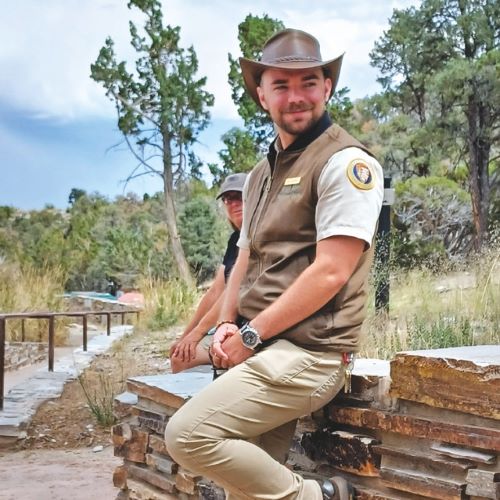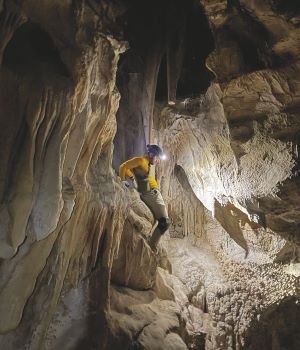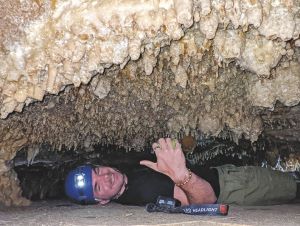
Turnip Turn-in: Park Ranger intern sets precedents for research classification and completion

Ryan Johnston ’23 says he’d be a very different person if he hadn’t attended The College of Wooster. The Ohio native came to play football and envisioned a career in sports marketing but fell in love with geology instead. In four short years, the playmaker became a precedent-setter in a field he never imagined being part of, leaving Wooster with impressive experiential learning and a National Park Service sanctioned research project.
It all started when Johnston enrolled in Geology of National Parks, a course taught by Shelley Judge, associate professor of earth sciences, who would become his Independent Study mentor. It was the first of many classes he took with Judge, and he came full circle by senior year working as her teaching apprentice.
“There are only a handful of caves in the world that have cave turnip formations and the research that we conducted has never been done before.” —Ryan Johnston ’23, I.S. title: The Morphology, Speleogenesis, and Classification of Cave Turnips in Lehman Caves, Great Basin National Park, Nevada (U.S.A.), mentor Shelley Judge, associate professor of earth sciences
When it came time to look for internships, Johnston cold-called several parks asking for a position. “I thought I would need scholarship funding for an unpaid internship, but Great Basin National Park in Nevada ended up giving me the highest-paid internship in the National Park Service,” said Johnston. He spent the summers after sophomore and junior years interning as a park ranger performing search and rescue, fire mitigation, and interpretation—talking to guests about the park and leading up to three cave tours each day for 60-90 minutes each. The tours came naturally for Johnston, who served as Wooster’s lead tour guide in Admissions. His double-major played a big role in his park ranger success too. “Geology gave me the knowledge, and communication studies gave me the ability to interpret and explain the environment,” said Johnston.

Johnston completed his research studying Cave Turnips in Lehman Caves, Great Basin National Park, Nevada. Photo: Serena Wurmse
During his first summer at the park in 2021, he asked a park geologist if she had any projects he could possibly use for Wooster I.S. She gave him a choice among three research topics the park was already planning to pursue. Johnston chose to complete the NPS’s research on cave turnips, globally rare structures formed in a cave by mineral deposits, also known as speleothems, that occur in abundance in Lehman Caves within Great Basin. He spent his junior I.S. writing a proposal to complete NPS research on cave turnips and did the work in summer 2022.
“Because of the preservation of our National Parks, all scientists need permission to access, research, and sample,” said Judge. “Instead of writing a ‘normal’ junior I.S. in our department, Ryan had to complete the National Park Service research proposal that would be read by outside scientists. It was challenging to accomplish in one semester, but he absolutely conquered it.” Johnston insists Judge’s support was “phenomenal,” and he could not have done any of this without her.
By day, he was a park ranger, but by night, Johnston organized a group of researchers to measure cave turnips. “My study works to determine why they have an unusual shape, how they form, and their relationship to other cave features,” said Johnston. “There are only a handful of caves in the world that have cave turnip formations, and the research that we conducted has never been done before.”
After creating his own classification system, Johnston led a “turnip team” of 17 fellow park rangers and scientists who volunteered to help him measure more than 1,000 cave turnips. They spent two to three hours each night and, counting everyone’s work, clocked a total of 500 hours that summer. Judge called this mobilization an incredible feat for an undergraduate research project.

Johnston climbed or squeezed into different cave rooms to locate cave turnip speleothems and measure the formations using field techniques. Photo: Kelsie Jackson
But that’s just the fieldwork. Back on campus, Johnston put his data from the caves into a spreadsheet and created dot-density maps in Adobe Illustrator to mark where each specimen/turnip was. He also sent samples from two turnips out to a lab for age-dating analysis. The findings placed the turnips at 60,000 and 250,000 years old (from the glacial and interglacial periods), which provided evidence for Johnston’s hypothesis that cave turnips form during wet, cool periods.
The unknown of the project was the most exciting part for Johnston. “I’d call Dr. Judge throughout the summer for guidance, and she’d always remind me that I was the first person to do this, so I’m setting the precedent and paving the way for future geologists,” recalled Johnston. “To do that when I didn’t even think I was going to be a geology major four years ago is pretty exciting.”
He also set a precedent for his classmates by claiming the #1 I.S. button in January, arriving at the registrar’s office at 6 a.m. (for an 8 a.m. opening) to submit his project. Nearly two dozen fraternity brothers showed up to support him that morning. Johnston already presented the work at the Geological Society of America October 2022 conference in Denver, and he’s pursuing official publication. He also began working full time the week after graduation as a wellsite geologist for the Columbine Corporation.
Photo 1: Serving as a tour guide and park ranger, Johnston applied the same charisma he used as an admissions tour guide at Wooster. Photo: Melanie Schultz
Posted in Independent Study on July 18, 2023.
Related Posts
Related Areas of Study
Geology
Start research in your first year and graduate with a strong foundation in the Earth Sciences.
Major MinorCommunication Studies
Be an effective listener, writer, and speaker who can think critically and connect with audiences
Major Minor

